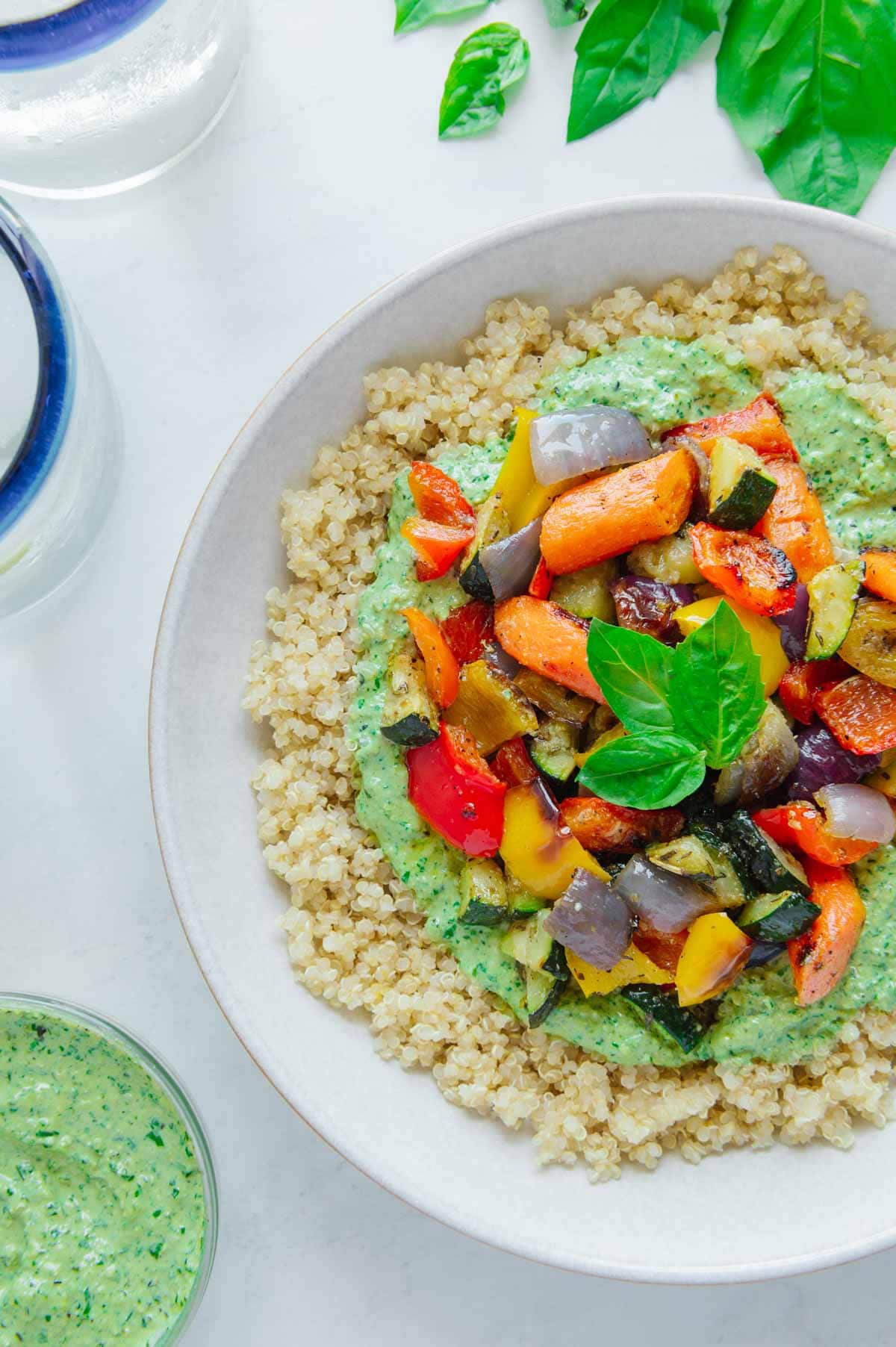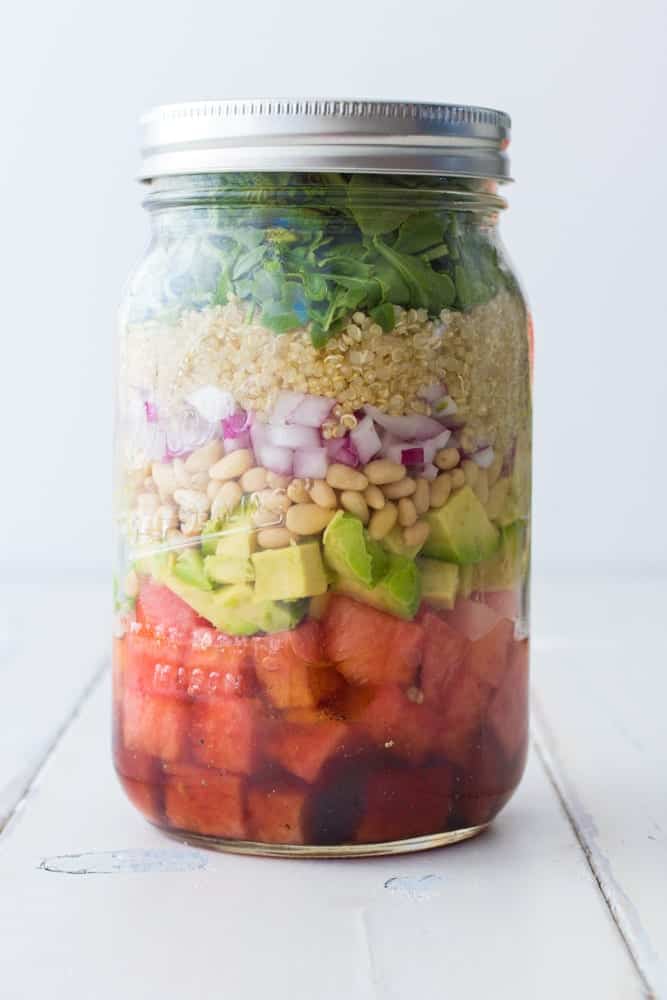Quinoa is a light yet nutrient-dense food that is staple for vegans. It is gluten-free, loaded with fiber and is considered a complete protein with all nine essential amino acids, in addition to being a good source of important minerals such as iron, zinc, magnesium, folate, among others. Here we'll discuss more on the health benefits of quinoa, how to cook it and recipes to put it to use.

I love how versatile quinoa is in that I can feature it in main dishes, add to salads for texture and even hide in baked goods. Given my background in public health, I always carefully select each ingredient in my plant-based recipes to ensure they are both delicious and nutritious, and quinoa is definitely on the A-list!


What is Quinoa?
Believe it or not, quinoa (pronounced KEEN-wah) is actually a seed and not a grain, even though for all intents and purposes it is cooked and used exactly like a grain. It is technically a pseudocereal like buckwheat and amaranth and is gluten-free. It is fluffy when cooked and has a very mild nutty and earthy taste.
Quinoa historically has been grown in South America (mainly Chile, Peru and Bolivia) for thousands of years, but given its surge in popularity it is now being grown in more than 50 countries throughout the world!

Nutrition Facts of Quinoa
According to the United States Department of Agriculture (USDA), a one cup serving of cooked quinoa contains 5 grams of dietary fiber, 118 mg of magnesium (28% of the daily value), 2.76 mg of iron (15% of the daily value), 77.7 mcg of folate (19% of the daily value) and 8 grams of protein. Here is the full nutrition breakdown from the USDA for a one-cup serving of quinoa:
- Calories: 222
- Total Fat: 3.55g
- Cholesterol: 0mg
- Sodium: 13mg
- Total Carbohydrates:
- Dietary Fiber: 5g
- Total Sugars: 1.61g
- Protein: 8.14g
- Iron: 2.76mg (15% of the daily value)
- Zinc: 2.02mg (18% of the daily value)
- Magnesium: 118mg (28% of the daily value)
- Manganese: 1.17mg (51% of the daily value)
- Folate: 77.7 mcg (19% of the daily value)
- Phosphorus: 281mg (22% of the daily value)
- Potassium: 318mg (7% of the daily value)
- Copper: 0.355mg (39% of the daily value)
- Vitamin B6: 0.228mg (13% of the daily value)

Health Benefits of Quinoa
Quinoa touts a tremendous amount of health benefits for vegans. It is a great source of fiber and plant-based protein, and in fact has more protein than other grains. Both fiber and protein play an important role in helping you feel full.
Quinoa also contains high amounts of zinc and iron, both of which can be challenging in a vegan diet. Zinc is necessary for cell growth, building proteins, healing damaged tissue and supporting a healthy immune system (source). Iron is important for maintaining healthy blood, and a deficiency in iron can cause fatigue and weakness (source).
In addition, regularly incorporating quinoa as part of an overall healthy diet has been shown to potentially help lower the risk of diabetes given they contain a flavanol with antioxidant properties called quercetin (source). Quercetin is a phytochemical with anti-inflammatory and heart-protecting qualities, and may also reduce the growth and spread of cancer cells.

The Colors of Quinoa - Is There a Difference?
Quinoa comes in three different colors: white, red and black. There are subtle differences between them, but I wouldn't say any are truly significant other than the color themselves. When choosing which one to use, I make my decision simply based on aesthetic reasons.
White quinoa, which is the most popular type, is most similar to rice as it is the mildest in terms of its nutty flavor. It is also slightly fluffier and chewier than red or black quinoa.
Red quinoa boasts a beautiful color and is wonderful for adding some contrast to your dishes depending on what you are serving with it. It is very similar to white quinoa in all other aspects, although it is slightly nuttier and crunchier in my opinion.
Black quinoa is the crunchiest and nuttiest of the three and also has a subtle sweetness about it. I love using black quinoa for contrast in dishes with mangos or avocados to show off their vibrant colors!
From a nutritional standpoint, there are no significant differences that would warrant choosing one color over the other. Black and red quinoa contain slightly more fiber than white quinoa, and black quinoa also contains a little more protein than red and white quinoa (sources: white, red, black), but again these differences are marginal. Regardless which color you choose, rest assured you are getting a lot of nutrients!
Should You Rinse Quinoa?
Quinoa naturally contains saponins on the outer layer which can be rinsed off with water. Saponins, a type of anti-nutrient with a bitter flavor, are typically found on legumes and grains and can interfere with normal nutrient absorption (source).
However, most quinoa that is sold in packages have already been pre-rinsed and are ready to cook. Therefore, it is generally not necessary to rinse quinoa.

How to Cook Quinoa
Cooking quinoa is so incredibly easy that I genuinely enjoy doing it! Whether on the stovetop or the Instant Pot, there is a foolproof way for each that guarantees you will never deal with burnt or undercooked crunchy quinoa again. Note that 1 cup of uncooked quinoa yields 3-4 cups of cooked quinoa.
Stovetop Method for Cooking Quinoa
For the stovetop, use a ratio of 2:1 for water and quinoa. For example, use 4 cups of water for 2 cups of quinoa. Once the water comes to a boil, add in the quinoa and boil for 5 minutes, then cover the pot tightly and turn the burner off and let it sit for at least 20 minutes. For more details and step by step instructions, see my post on How to Make Perfectly Cooked Quinoa (stovetop). You will be amazed! This method yields light and fluffy quinoa that is not soggy or burnt. Properly cooked quinoa is the key to enjoying it!

Instant Pot Method for Cooking Quinoa
For the Instant Pot, use a ratio of 1:1 for water and quinoa. That means to use 1 cup of water for 1 every cup of quinoa. Cook the quinoa on "Manual/High Pressure" for one minute, then turn it off and allow the pressure to naturally release. After about 15 minutes when the floating valve drops, open the lid and fluff with a fork. That's it! For more details and step by step instructions, see my post on How to Make Perfectly Cooked Quinoa in the Instant Pot.
Vegan Recipes Featuring Quinoa









Quinoa is so versatile that you literally could eat it for breakfast, lunch and dinner if you wanted. Below are vegan recipes featuring quinoa that are sure to please. For even more recipes check out my post on Pantry Staples That Do it All: Quinoa.
- Breakfast
- Appetizers/Sides
- Vegan Sweet Potato Quinoa Tots (this can also be an entree for kids)
- Quinoa & Mango Stuffed Grilled Avocado
- Quinoa Stuffing
- Quinoa Tabbouleh
- Salads
- Spring/Summer
- Easy Vegan Mexican Quinoa Salad
- Vegan Mediterranean Quinoa Salad
- Crispy Quinoa and Avocado Salad with Strawberry Vinaigrette
- Berry-Cherry Quinoa Salad with Candied Walnuts and Balsamic-Shallot Vinaigrette
- Watermelon Arugula Mason Jar Salad with Quinoa, Avocado, Pine Nuts & Mint
- Mango-Avocado Quinoa Salad with Toasted Pepitas
- Fall/Winter
- Spring/Summer
- Bowls
- Dinners
- Vegan Enchilada Stuffed Bell Peppers
- Vegan Greek Quinoa Sheetpan Dinner
- Quinoa Black Bean Veggie Burgers
- Quinoa-Pecan Stuffed Acorn Squash
- Roasted Veggies & Crispy Chickpeas over Quinoa with Garlic Maple Tahini Drizzle
- Quick & Easy One-Pot Curried Quinoa & Chickpeas
- Roasted Beet Noodles Over Quinoa with Parsley Pesto
- Quinoa Minestrone Soup
- Easy Vegan Stir Fry
- Energy Bites

Please comment below with your favorite way to incorporate quinoa into your diet, and tag @eatingbyelaine on Instagram so I can see your final shots of any of these recipes you make!

Karen Kramer says
This is the only way I make quinoa now!
Elaine Gordon says
Thank you so much, Karen! I'm thrilled to hear you enjoyed this method. Did you end up doing the stovetop or Instant Pot version?